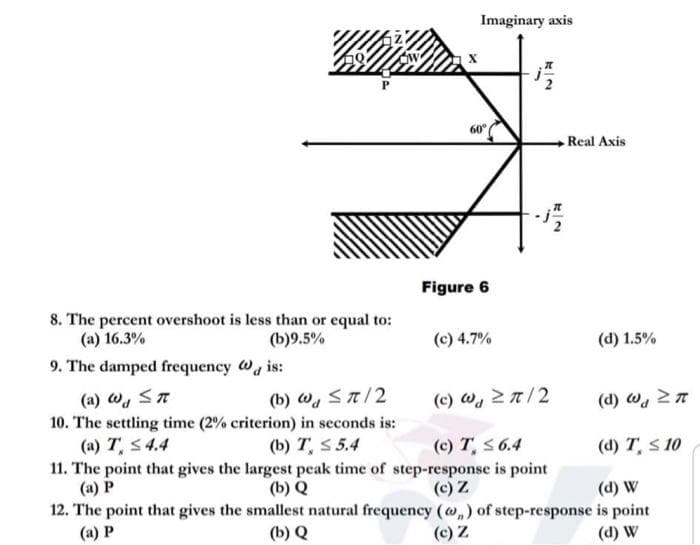8. The percent overshoot is less than or equal to: (a) 16.3% (b)9.5% (c) 4.7% (d) 1.5% 9. The damped frequency W, is: (a) W, ST 10. The settling time (2% criterion) in seconds is: (b) W, ST/2 (c) W, 2 n/ 2 (d) W. 2 7 (a) T S4.4 11. The point that gives the largest peak time of step-response is point (a) P 12. The point that gives the smallest natural frequency (w,) of step-response is point (a) P (b) T, S 5.4 (c) T, S6.4 (d) T, S 10 (b) Q (c) Z (d) W (b) Q (c) Z (d) W
8. The percent overshoot is less than or equal to: (a) 16.3% (b)9.5% (c) 4.7% (d) 1.5% 9. The damped frequency W, is: (a) W, ST 10. The settling time (2% criterion) in seconds is: (b) W, ST/2 (c) W, 2 n/ 2 (d) W. 2 7 (a) T S4.4 11. The point that gives the largest peak time of step-response is point (a) P 12. The point that gives the smallest natural frequency (w,) of step-response is point (a) P (b) T, S 5.4 (c) T, S6.4 (d) T, S 10 (b) Q (c) Z (d) W (b) Q (c) Z (d) W
Power System Analysis and Design (MindTap Course List)
6th Edition
ISBN:9781305632134
Author:J. Duncan Glover, Thomas Overbye, Mulukutla S. Sarma
Publisher:J. Duncan Glover, Thomas Overbye, Mulukutla S. Sarma
Chapter6: Power Flows
Section: Chapter Questions
Problem 6.27P
Related questions
Question
100%
Give all answer or don't attempt.

Transcribed Image Text:Imaginary axis
60"
Real Axis
Figure 6
8. The percent overshoot is less than or equal to:
(a) 16.3%
(b)9.5%
9. The damped frequency Wa is:
(c) 4.7%
(d) 1.5%
(a) w. ST
10. The settling time (2% criterion) in seconds is:
(a) T S4.4
11. The point that gives the largest peak time of step-response is point
(a) P
12. The point that gives the smallest natural frequency (,) of step-response is point
(b) w, ST/2
(c) W, 2n/2
(d) w. 2n
(b) T, S 5.4
(c) T S6.4
(d) T S 10
(b) Q
(c) Z
(d) W
(a) P
(b) Q
(c) Z
(d) W
Expert Solution
This question has been solved!
Explore an expertly crafted, step-by-step solution for a thorough understanding of key concepts.
This is a popular solution!
Trending now
This is a popular solution!
Step by step
Solved in 2 steps with 4 images

Knowledge Booster
Learn more about
Need a deep-dive on the concept behind this application? Look no further. Learn more about this topic, electrical-engineering and related others by exploring similar questions and additional content below.Recommended textbooks for you

Power System Analysis and Design (MindTap Course …
Electrical Engineering
ISBN:
9781305632134
Author:
J. Duncan Glover, Thomas Overbye, Mulukutla S. Sarma
Publisher:
Cengage Learning

Power System Analysis and Design (MindTap Course …
Electrical Engineering
ISBN:
9781305632134
Author:
J. Duncan Glover, Thomas Overbye, Mulukutla S. Sarma
Publisher:
Cengage Learning